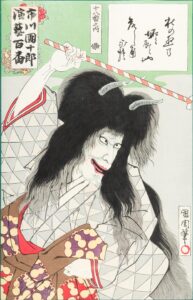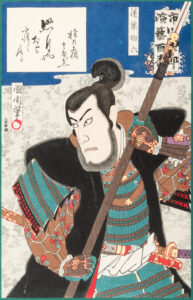By Erin Escobar

Ukiyo-e is a Japanese art form that arose during the Edo period (1603-1868). It was comprised of woodblock prints in black and white until the 1760s when a polychromatic system was developed, allowing for mass printing of woodblock prints. The word ukiyo-e (pronounced uki•yo–e) means “pictures of the floating world.” The “floating world” refers to the momentary pleasures of the urban middle class in the city of Edo (modern day Tokyo), and the most common subject of the prints were various aspects of the pleasure district such as portraits of famous courtesans and prostitutes, kabuki actors, and erotica. In later years, landscapes, birds and flowers, dramatic historical events, and even ghoulish subjects, grew in popularity.
The most popular subject of ukiyo-e was kabuki actor portraits, reflecting a national love for the art form. Kabuki is a type of Japanese theatre which was founded in 1603 by a Shinto priestess. Despite strict regulation, kabuki gained in popularity throughout the Edo period as the commoners’ chief form of entertainment. Kabuki was largely subversive and eccentric in the Edo period; the themes usually centered on the conflicts and social affairs of the day, and were often disguised to pass regulations.

Featured in our auction on June 5, 2014 are over 40 ukiyo-e woodblock prints from the collection of Doyce B. Nunis, Jr., a California historian, writer, author, and editor, who took an interest in and collected Japanese and other Asian art. Of particular interest in his collection are lots 313-318: Six ukiyo-e woodblock portraits of the kabuki actor Danjūrō IX (1838–1903), of the famed Ichikawa Family of actors flourishing in the kabuki theatre from the 17th century to the modern day. Danjūrō is the highest honorific name, and there have been twelve Danjūrō to date, the first Danjūrō debuted in 1673. The honorific name Danjūrō is adopted as the actor’s name usually at the height of his career. Danjūrō IX of the Meiji period (1868-1912), revitalized the theatre and participated in the first kabuki performance in front of the emperor. These six prints are by the artist Toyohara Kunichika (1835-1900) from his series Ichikawa Danjūrō engei hyakuban or “One Hundred Roles of Ichigawa Danjūrō.” Here, Danjūrō IX is portrayed as a scribe, a sailor, warrior, oni (demon), and in onnagata (dressed as a woman).
The artist Kunichika (born Yasohachi Oshima) was an interesting character and a self-described “womanizer and man on the move,” who was also known to drink too much, and spend lots of time in brothels. He began his career in ukiyo-e printmaking as an apprentice in the studio of Kunisada after a few years training under Chikanobu. His name is a combination of the names of the two ukiyo-e masters: Kunisada and Chikanobu = Kunichika. The artist was passionate about kabuki and spent much of his time backstage sketching actors.
Kunichika’s color choices and distinct style of rendering the captivating characters created by Ichigawa Danjūrō, make these prints the most interesting kabuki portraits among the Doyce B. Nunis, Jr. collection